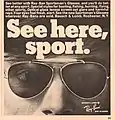Ray-Ban
Ray-Ban is an American-Italian brand of luxury sunglasses and eyeglasses created in 1936 by Bausch & Lomb. The brand is known for its Wayfarer and Aviator lines of sunglasses. In 1999, Bausch & Lomb sold the brand to Italian eyewear conglomerate Luxottica Group for a reported $640 million.[1]
 | |
.jpg.webp) Headquarters in Milan, Italy | |
| Type | Subsidiary |
|---|---|
| Industry | Eyewear |
| Founded | 1936 in Rochester, New York, United States |
| Headquarters | , Italy |
Area served | Worldwide |
| Products | |
| Owner | Luxottica Group |
| Website | ray-ban.com |
History
In 1929, US Army Air Corps Colonel John A. Macready worked with Bausch & Lomb, a Rochester, New York-based medical equipment manufacturer, to create aviation sunglasses that would reduce the distraction for pilots caused by the intense blue and white hues of the sky.[2][3][4]
Specifically, MacCready was concerned about how pilots' goggles would fog up, greatly reducing visibility at high altitude.[5] The prototype, created in 1936 and known as "Anti-Glare", had plastic frames and green lenses that could cut out the glare without obscuring vision. The name "Ray-Ban" was hence derived from the ability of these glasses to limit the ingress of either ultra-violet or infra-red rays of light.[6] Impact-resistant lenses were added in 1938.[7] The sunglasses were redesigned with a metal frame the following year and patented as the Ray-Ban Aviator.[5] According to the BBC, the glasses used “Kalichrome lenses designed to sharpen details and minimise haze by filtering out blue light, making them ideal for misty conditions.”[5]
In 1999, the Global Eyewear Division of Bausch & Lomb, including Ray-Ban was acquired by Luxottica Group for US$240 million.[1]
In 2021, Ray-Ban commercialized a model of smart glasses that they developed with Facebook Reality Labs called Ray-Ban Stories.[8][9]
Sunglasses lines
Ray-Ban's most popular sunglasses are the Wayfarer, Erika, and Aviator models.[5][10][11] During the 1950s, Ray-Ban released the Echelon (Caravan), which had a squarer frame. In 1965, the Olympian I and II were introduced; they became popular when Peter Fonda wore them in the 1969 film Easy Rider.[12] The company has also produced special edition lines, such as The General in 1987, bearing similarity to the original aviators worn by General Douglas MacArthur during the Second World War.[7] In the 1980s the Ray-Ban Clubmaster was added to the model line.[13] The Clubmaster has a browline frame and went on to become the third best selling sunglasses style of the 1980s, behind the Wayfarer and Aviator.[14]
Gallery
 Ray-Ban 3025 Large Metal Aviator (polarized lenses)
Ray-Ban 3025 Large Metal Aviator (polarized lenses)_Size_62_09_160_Lens_base_6.jpg.webp) Ray-Ban 3139 Shooter (G-15 lenses)
Ray-Ban 3139 Shooter (G-15 lenses) Ray-Ban W163 Outdoorsman (B-20 Chromax lenses)
Ray-Ban W163 Outdoorsman (B-20 Chromax lenses) 1968 Ray-Ban Outdoorsman advertisement
1968 Ray-Ban Outdoorsman advertisement Ray-Ban 2132 901L Wayfarer
Ray-Ban 2132 901L Wayfarer Ray-Ban 3016 Clubmaster
Ray-Ban 3016 Clubmaster Ray-Ban 2447 Round Fleck Icons
Ray-Ban 2447 Round Fleck Icons Ray-Ban 5277 prescription eyeglasses frame
Ray-Ban 5277 prescription eyeglasses frame Ray-Ban 4246 Clubround sunglasses in colours of black and gold
Ray-Ban 4246 Clubround sunglasses in colours of black and gold
References
- "Company News: Bausch & Lomb Selling Sunglass Business to Luxottica". NY Times. April 29, 1999. Retrieved September 5, 2010.
- Pagan Kennedy (3 August 2012). "Who Made Those Aviator Sunglasses?". New York Times. Archived from the original on 21 August 2012. Retrieved 1 May 2017.
And so Macready began working with Bausch & Lomb to design goggles especially suited to protect against the dazzle in the stratosphere. “My dad gave Bausch & Lomb the original shape, tint and fit” of aviator lenses, Wallace said.
- "The best ever ray-bans".
- "You can thank the US military for the world's most famous sunglasses". Business Insider France (in French). Retrieved 2017-05-24.
- Foreman, Katya. "The enduring appeal of aviator sunglasses".
- "What is the name origin of the Ray-Ban brand?". High Names. 22 March 2013. Retrieved 2021-07-27.
- "Fashion Notes". 24 May 1987. Archived from the original on 18 October 2016.
{{cite journal}}: Cite journal requires|journal=(help) - "Ray-Ban and Facebook roll out smart sunglasses that can film everything you look at". 9 September 2021.
- "RAY-BAN STORIES".
- Williamson, Charlote; Davis (1 September 2007). 101 Things to Buy Before You Die. New Holland Publishers. ISBN 9781845378851 – via Google Books.
- Shilling, Donovan A. (1 January 2011). A Photographic History of Bausch + Lomb. Pancoast Publishing. ISBN 9780983849605 – via Google Books.
- "Mad Men Don Draper Meets Peter Fonda in Easy Rider (1969)". 14 November 2014.
- RAY-BAN: THE HISTORY OF THE TOP-SELLING EYEWEAR BRAND WORLDWIDE
- Fassel, Preston. "Hindsight is 20/20: The Browline". The Optician's Handbook. Retrieved 2013-06-10.